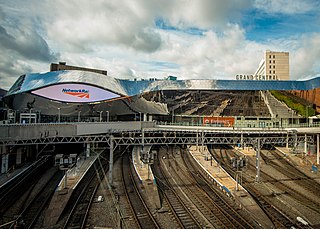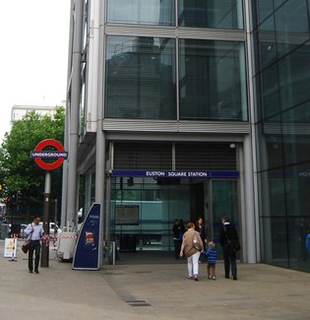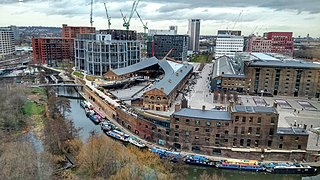
King's Cross railway station, also known as London King's Cross, is a passenger railway terminus in the London Borough of Camden, on the edge of Central London. It is in the London station group, one of the busiest stations in the United Kingdom and the southern terminus of the East Coast Main Line to North East England and Scotland. Adjacent to King's Cross station is St Pancras International, the London terminus for Eurostar services to continental Europe. Beneath both main line stations is King's Cross St Pancras tube station on the London Underground; combined they form one of the country's largest and busiest transport hubs.

Kings Cross is a district on either side of Euston Road, in north London, England, 1.5 miles (2.4 km) north of Charing Cross. It is bordered by Barnsbury to the north, Clerkenwell and Islington to the east, Holborn to the south and Euston to the west. It is served by two major rail termini, St Pancras and King's Cross. King's Cross station is the terminus of one of the major rail routes between London and the North.

High Speed 1 (HS1), legally the Channel Tunnel Rail Link (CTRL), is a 67-mile (108 km) high-speed railway linking London with the Channel Tunnel.

Euston railway station is a central London railway terminus in the London Borough of Camden, managed by Network Rail. It is the southern terminus of the West Coast Main Line, the UK's busiest inter-city railway. Euston is the eleventh-busiest station in Britain and the country's busiest inter-city passenger terminal, being the gateway from London to the West Midlands, North West England, North Wales and Scotland.

Birmingham New Street is the largest and busiest of the three main railway stations in Birmingham city centre, England, and a central hub of the British railway system. It is a major destination for Avanti West Coast services from London Euston, Glasgow Central and Edinburgh Waverley via the West Coast Main Line, the CrossCountry network, and for local and suburban services within the West Midlands; this includes those on the Cross-City Line between Lichfield Trent Valley, Redditch and Bromsgrove, and the Chase Line to Walsall and Rugeley Trent Valley. The three-letter station code is BHM.

Euston Road is a road in Central London that runs from Marylebone Road to King's Cross. The route is part of the London Inner Ring Road and forms part of the London congestion charge zone boundary. It is named after Euston Hall, the family seat of the Dukes of Grafton, who had become major property owners in the area during the mid-19th century.

King's Cross St Pancras is a London Underground station on Euston Road in the Borough of Camden, Central London. It serves King's Cross and St Pancras main line stations in fare zone 1, and is an interchange between six Underground lines. The station was one of the first to open on the network. As of 2021, it is the most used station on the network for passenger entrances and exits combined.
Somers Town is an inner-city district in North West London. It has been strongly influenced by the three mainline north London railway termini: Euston (1838), St Pancras (1868) and King's Cross (1852), together with the Midland Railway Somers Town Goods Depot (1887) next to St Pancras, where the British Library now stands.

St Pancras railway station, also known as London St Pancras or St Pancras International and officially since 2007 as London St Pancras International, is a central London railway terminus on Euston Road in the London Borough of Camden. It is the terminus for Eurostar services from Belgium, France and the Netherlands to London. It provides East Midlands Railway services to Leicester, Corby, Derby, Sheffield and Nottingham on the Midland Main Line, Southeastern high-speed trains to Kent via Ebbsfleet International and Ashford International, and Thameslink cross-London services to Bedford, Cambridge, Peterborough, Brighton, Horsham and Gatwick Airport. It stands between the British Library, the Regent's Canal and London King's Cross railway station, with which it shares a London Underground station, King's Cross St Pancras.

King's Cross Thameslink station is a closed railway station in central London, England. It is located on Pentonville Road, around 250 metres (0.2 mi) east of King's Cross mainline station. At the time of closure, in 2007, it was served by Thameslink trains and managed by First Capital Connect.

Euston is a London Underground station. It directly connects with Euston main line station above it. The station is in Travelcard Zone 1.

Angel is a London Underground station in the Angel area of the London Borough of Islington. It is on the Bank branch of the Northern line, between King's Cross St. Pancras and Old Street stations, in Travelcard Zone 1. The station was originally built by the City & South London Railway (C&SLR) and opened on 17 November 1901. The station served as a terminus until the line was extended to Euston on 12 May 1907.

Euston Square is a London Underground station at the corner of Euston Road and Gower Street, just north of University College London – its main entrance faces the tower of University College Hospital. The multi-interchange Euston station is beyond Euston Square Gardens, which is one street east. The station is between Great Portland Street and King's Cross St Pancras on the Circle, Hammersmith & City and Metropolitan lines in Travelcard Zone 1.

The Charing Cross, Euston and Hampstead Railway (CCE&HR), also known as the Hampstead Tube, was a railway company established in 1891 that constructed a deep-level underground "tube" railway in London. Construction of the CCE&HR was delayed for more than a decade while funding was sought. In 1900 it became a subsidiary of the Underground Electric Railways Company of London (UERL), controlled by American financier Charles Yerkes. The UERL quickly raised the funds, mainly from foreign investors. Various routes were planned, but a number of these were rejected by Parliament. Plans for tunnels under Hampstead Heath were authorised, despite opposition by many local residents who believed they would damage the ecology of the Heath.

The Euston Arch, built in 1837, was the original entrance to Euston station, facing onto Drummond Street, London. The arch was demolished when the station was rebuilt in the 1960s, but much of the original stone was later located—principally used as fill in the Prescott Channel—and proposals have been formulated to reconstruct it as part of the planned redevelopment of the station, including the station's use as the London terminus of the High Speed 2 line.

King's Cross Central (KXC) is a multi-billion pound mixed-use development in the north-east of central London. The site is owned and controlled by the King's Cross Central Limited Partnership. It consists of approximately 67 acres (27 ha) of former railway lands to the north of King's Cross and St Pancras mainline railway stations. The site is largely determined by three boundaries: the existing East Coast Main Line railway leading out of King's Cross; York Way, a road marking the division between Camden and Islington boroughs; and the new railway line, High Speed 1 (HS1), formerly known as the Channel Tunnel Rail Link, which curves around the site to the north and west.

Crossrail 2 is a proposed hybrid commuter rail and rapid transit route in South East England, running from nine stations in Surrey to three in Hertfordshire, providing a new North–South rail link across Greater London. It would connect the South West Main Line to the West Anglia Main Line, via Victoria and King's Cross St Pancras. It is intended to alleviate severe overcrowding that would otherwise occur on commuter rail routes into Central London by the 2030s. Should permission be granted, construction is expected to start around 2023, with the new line opening from the early 2030s. The project's cost has been estimated at £31.2 billion.

London Waterloo International station was the London terminus of the Eurostar international rail service from its opening on 14 November 1994 to its closure on 13 November 2007, when it was replaced by London St Pancras International as the terminal for international rail services. It was on the western side of London Waterloo mainline station but was managed and branded separately.
The North Western and Charing Cross Railway (NW&CCR) was a railway company established in 1864 to construct an underground railway in London. The NW&CCR was one of many underground railway schemes proposed for London following the opening in 1863 of the Metropolitan Railway, the world's first underground railway, but was one of only a few to be authorised by Parliament. The company struggled to raise funding for the construction of its line and was twice renamed, to the Euston, St Pancras and Charing Cross Railway and the London Central Railway, before the proposals were abandoned in 1874.

The statue of John Betjeman at St Pancras railway station, London is a depiction in bronze by the sculptor Martin Jennings. The statue was designed and cast in 2007 and was unveiled on 12 November 2007 by Betjeman's daughter, Candida Lycett Green and the then Poet Laureate Andrew Motion to commemorate Betjeman and mark the opening of St Pancras International as the London terminus of the Eurostar high-speed rail link between Great Britain and mainland Europe. The location memorialises the connection between St Pancras station and Betjeman, an early and lifelong advocate of Victorian architecture.


















